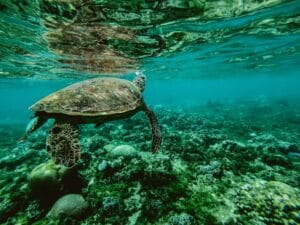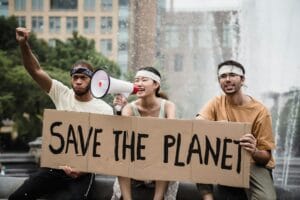Introduction
Water and climate change are inextricably linked. Extreme weather makes water scarce, less predictable, and more polluted (UN Water, n.d.). Waterway pollution is becoming a critical global concern as climate change intensifies extreme weather events. Storms, floods, and hurricanes are now more frequent and more destructive, placing immense pressure on natural and built water systems. These events trigger runoff, sewage overflows, and chemical spills, contaminating rivers, lakes, and coastal environments. In Australia, severe floods and cyclones often damage infrastructure and overload drainage, causing pollutants to enter waterways. Around the world, communities and ecosystems face growing risks from contaminated water and reduced water quality. This article explores how extreme weather contributes to waterway pollution and highlights the policies and technologies needed to reduce its impact.
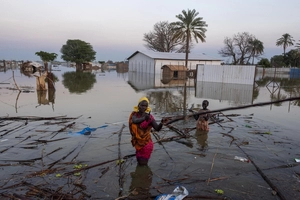
Source: UN Water, n.d.
Definition of Relevant Extreme Weather Events and Water Pollution
An extreme weather event is an unusual occurrence for a specific place and time of year, marked by exceptional intensity, location, timing, or scale. The characteristics of extreme weather may vary from place to place in an absolute sense (World Meteorological Organization [WMO], n.d.). These events, such as droughts, floods, heavy rains, tropical storms, heatwaves, and fire weather are escalating in incidence and intensity. Examples of these climate events include, but are not limited to, heatwaves, cold waves, heavy precipitation, drought, storms, floods, tornadoes, hurricanes, and tropical cyclones. This article will focus on storms, floods, and hurricanes (National Ocean Service, n.d.). These events produce intense rainfall and rapid water flow, which disturb natural and human-made systems.
What is a hurricane?
Source: NOAA, n.d.
Runoff from cities, farms, and industrial areas collect pollutants like fertilisers, oil, plastics, and heavy metals. These contaminants are then carried into rivers, lakes, and coastal waters. Floods can overwhelm sewage systems, releasing untreated waste into the environment. Storm surges and high winds damage infrastructure, increasing the risk of chemical spills and widespread contamination (Atkinson & Willige, 2025). Together, these impacts contribute to serious and often long-lasting waterway pollution.
How Storms, Floods, and Hurricanes Contribute to Waterway Pollution
Storms, floods, and hurricanes contribute to waterway pollution by intensifying the movement of water through contaminated environments. For example, heavy rainfall from storms washes pollutants from roads, farms, and construction sites into nearby waterways. Floods overflow drainage systems, spreading waste, fertilisers, and chemicals across urban and rural areas. Moreover, strong winds and storm surges from hurricanes damage industrial sites, leading to chemical spills and fuel leaks. These events disrupt natural filters like wetlands that normally absorb pollutants (National Oceanic and Atmospheric Administration, 2025).
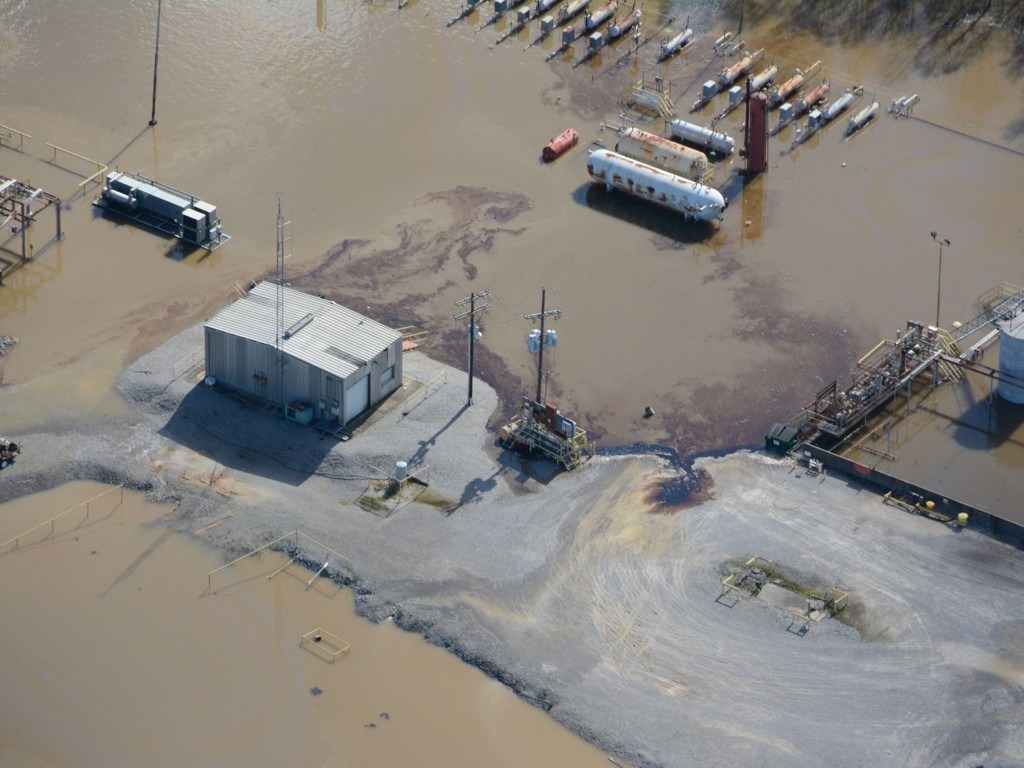
Source: Austin Sentinel, 2016
When these weather events strike, they often overwhelm ageing water infrastructure. Wastewater systems may release untreated sewage into rivers and lakes. Industrial discharge points may malfunction, increasing the release of hazardous materials. Floodwaters also carry solid waste, plastics, and debris into aquatic ecosystems. As floodwaters recede, contaminants settle into sediment, causing long-term environmental damage. These combined effects make storms, floods, and hurricanes major drivers of waterway pollution around the world (Price, 2024).
What are Stormwater Pollutants?
Source: YouTube, n.d.
Case Studies: Cyclone Alfred (2025)
Cyclone Alfred (2025)
In March 2025, Cyclone Alfred made landfall in Southeast Queensland, bringing unprecedented rainfall and severe flooding to Brisbane and surrounding regions. The Brisbane central business district (CBD) recorded approximately 260 millimetres of rainfall in a single day, leading to widespread inundation in low-lying suburbs such as Woolloongabba, Rocklea, Wavell Heights, Stones Corner, and Windsor (ABC, 2025). For context, Brisbane usually gets about 10 millimetres of rain per day in March, so the 260 millimetres during Cyclone Alfred was over 25 times the daily average (Bureau of Meteorology, 2025).
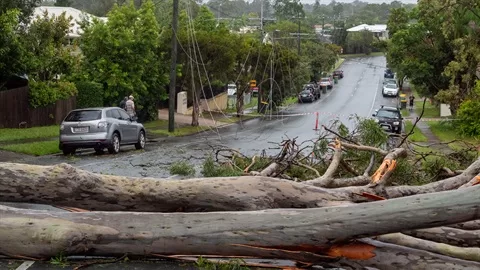
Source: Moreton Bay Regional Council, 2025
The intense rainfall overwhelmed the city’s stormwater infrastructure, resulting in significant waterway pollution through several mechanisms:
- Sewage Overflows: Urban Utilities had to release raw sewage into the Brisbane River owing to stormwater overwhelming critical projects, leading to contamination concerns between Lucas Park and Colmslie Beach Reserve (Morningside News, n.d.).
- Industrial Discharges: The heavy rains caused a large hole to appear in an earth wall at the Mount Gravatt quarry, leading to concerns about potential contamination. However, BMI Group, the quarry’s owner, denied allegations of contamination, stating that water in the stormwater containment pond was tested and found safe for release (Mount Gravatt News, n.d.).
- Infrastructure Damage: The cyclone’s strong winds and flooding led to power outages affecting over 330,000 properties, disrupting water treatment facilities, and increasing the risk of untreated wastewater entering natural waterways (ABC, 2025).
- Elevated Enterococci Levels: Following the cyclone, enterococci levels—a key indicator of faecal contamination—were expected to have increased significantly in the Brisbane River. Historical data show that heavy rainfall events lead to sharp rises in enterococci concentrations owing to stormwater runoff carrying pollutants from urban, industrial, and agricultural areas into the river system (Brisbane City Council, 2025).
Policies and Regulations for Water Pollution Prevention
In light of increasing extreme weather events, such as storms, floods, and hurricanes, Australia has implemented a range of policies and regulations aimed at preventing and mitigating waterway pollution. These measures address the challenges posed by climate change and its impact on water quality.
National Frameworks
National Water Quality Management Strategy (NWQMS):
Firstly, This strategy provides a comprehensive framework for water quality planning and management across Australia. In addition, It offers guidelines to achieve water quality objectives, emphasising the importance of maintaining healthy aquatic ecosystems and ensuring safe water for human use (Australian Government, 2018).
Reef 2050 Water Quality Improvement Plan:
Specifically targeting the Great Barrier Reef, this plan sets ambitious targets to reduce pollutants entering the reef’s waters by 2050. Goals include a 60% reduction in dissolved inorganic nitrogen, a 25% reduction in sediment, and a 20% reduction in particulate nutrient loads. These efforts aim to protect the reef from the adverse effects of water pollution exacerbated by extreme weather events (Queensland Government, n.d.).
State and Territory Initiatives
Water Quality Improvement Plans (WQIPs):
Developed for regions identified as water quality hotspots, WQIPs establish strategies for managing pollution in waterways of high ecological and social value. These plans involve identifying pollution sources, setting reduction targets, and implementing management actions tailored to specific catchments (IDC-Online, n.d.).
Extreme Events Policies:
Recognising extreme weather’s impact on water quality, policies like New South Wales’ Extreme Events Policy outline steps to manage shortages and water issues during droughts and floods. These policies facilitate early intervention and provide guidelines for responding to water quality challenges posed by extreme climatic conditions (NSW Department of Planning and Environment, 2023).
Urban Water Management
Water-Sensitive Urban Design (WSUD):
WSUD is an approach that integrates the urban water cycle, including stormwater, groundwater, and wastewater management, into urban design. It aims to minimise environmental degradation and improve aesthetic and recreational appeal. By incorporating WSUD principles, urban areas can better manage runoff during extreme weather events, reducing the risk of waterway pollution. These policies show Australia’s commitment to protecting water quality amid more frequent extreme weather events. Australia uses national, state, and local strategies to reduce climate change impacts on waterways and protect aquatic ecosystems (Melbourne Water, n.d.).
Technological Innovations to Mitigate Waterway Pollution
Extreme weather events such as storms, floods, and hurricanes significantly exacerbate waterway pollution by introducing various contaminants into aquatic ecosystems. To combat these challenges, several technological innovations have been developed to prevent and mitigate water pollution.
Advanced Filtration Systems
Modern filtration technologies have been instrumental in removing pollutants from water sources. For instance, a novel sponge made from cotton and squid bone has demonstrated the ability to absorb approximately 99.9% of microplastics in water samples. This scalable solution offers a promising approach to addressing microplastic contamination in aquatic environments (Perkins, 2024). These technologies support Science-Based Targets by offering scalable, low-carbon solutions that reduce waste. However, using an animal product (squid bone) in novel sponge is not vegan so not a 100% thrivable solution.
Artificial Intelligence (AI) and Machine Learning
AI technologies are increasingly being employed to enhance water pollution management. In Australia, researchers have developed AI programs capable of rapidly analysing water samples to detect microplastic contamination. These systems utilise machine learning algorithms to identify and differentiate artificial compounds, significantly expediting the process of monitoring and addressing plastic pollution in oceans (Duckett, 2025).
Bioremediation Techniques
Bioremediation leverages natural processes involving microorganisms and plants to degrade or remove pollutants from water. Techniques such as phytoremediation use plants to absorb and break down contaminants, while constructed wetlands mimic natural filtration systems to purify water (Habitatpoint, n.d. & Nti et al., 2023). These eco-friendly approaches offer sustainable solutions for improving water quality. These technologies also support Science-Based Targets by offering the adoption of circular economy practices.
Internet of Things (IoT) Monitoring Systems
IoT devices equipped with sensors can provide real-time monitoring of water quality parameters, enabling prompt detection of pollution events. These systems facilitate proactive management of water resources by collecting and transmitting data on factors such as pH, turbidity, and contaminant levels, allowing for timely interventions to prevent environmental damage (Forhad et al., 2024).
Autonomous Cleaning Robots
Robotic technologies have been developed to remove waste from water bodies efficiently. For example, autonomous underwater robots equipped with AI and image processing capabilities can identify and collect debris, reducing pollution levels in aquatic environments (Deayton, 2022).
These robots offer a scalable solution for maintaining waterway cleanliness, especially in areas affected by extreme weather events. Using new technologies can greatly improve how we prevent and reduce waterway pollution, especially after extreme weather events. Ongoing research and investment are key to protecting water resources and supporting environmental sustainability.
Conclusion and Call to Action
Policy Implementation: Governments must enforce stringent regulations to control pollutant discharges and manage land use effectively.
Technological Innovation: Investing in advanced water treatment technologies and sustainable urban planning can mitigate pollution impacts.
Community Engagement: Public awareness and participation are crucial in adopting best practices for pollution prevention.
Achieving THRIVE goals and SDGs
Waterway pollution and extreme weather events fits well with the THRIVE Framework. It particularly supports these three foundational focus factors:
Science-Based Targets:
Science-Based Targets is a systematic and quantitative process, undertaken by gathering evidence through experimentation. Observation must be undertaken and condensed into testable theories. Mitigation should be theoretically valid, measurable, and explainable by clear and analytical rationale. Waterway pollution and extreme weather events provide measurable evidence that helps set Science-Based Targets to guide effective and evidence-driven environmental action.
Complex Wicked Problems:
A Complex Wicked Problem is one where every attempt to solve it reshapes how the problem is understood. Waterway pollution and extreme weather events are examples of Complex Wicked Problems because they are interconnected, constantly evolving, and influenced by multiple social, environmental, and economic factors, making them difficult to fully understand or solve with one-time solutions.
Systems Thinking:
With regard to Systems Thinking, for a thrivable world beyond sustainability, we must consider all aspects across every level. Furthermore, we need to examine how these aspects intersect with each other. Waterway pollution and extreme weather events relate to Systems Thinking because they result from interconnected factors across individual, community, institutional, and planetary levels, highlighting the need for holistic, multi-level approaches to create sustainable and thrivable solutions.
Moreover, addressing waterway pollution intensified by extreme weather events aligns with the following Sustainable Development Goals (SDGs):
SDG6: Clean Water and Sanitation
SDG6: Clean Water and Sanitation aims to ensure the availability and sustainable management of water resources, directly targeting pollution reduction. But despite this goal, billions of people around the world still do not have clean drinking water or proper sanitation (United Nations, 2023). This shows that SDG6, while important, is not enough on its own. It often lacks clear steps and strong accountability to make real progress, especially in places with fewer resources or complex challenges. Science-Based Targets, help SDG6 enable organisations to define goals based on scientific discoveries. Therefore, water scarcity is a huge Complex Wicked Problem. Indicative of the characteristics of wicked problems, there are often a lot of possible solutions to consider (Rittel, et al., 1973). Many of these solutions take into account unique regional factors alongside expected and unexpected effects and outcomes locally, regionally, and globally (Woods, 2023).
SDG13: Climate Action
SDG13: Climate Action calls for adaptive strategies to address climate change, including its effects on water quality. Science-Based Targets with low-carbon technologies, waste reduction, and the adoption of circular economy practices, can combat climate change and help SDG13 (EU-ASEAN, n.d. & DEEP, 2024). Clearly, human-induced climate change is a “wicked problem par excellence”. Indeed, this is so because, its causes are multiple and complex, its impacts are uncertain and interrelated, and potential solutions to climate change might well cause further problems. Climate change does not arise from one single event and does not cause one solitary result.
SDG14: Life Below Water
SDG14: Life Below Water focuses on conserving and sustainably using marine resources, which involves preventing and mitigating waterway pollution. By pursuing these goals, we can develop integrated approaches that address the multifaceted challenges posed by extreme weather events on water systems. For a thrivable world beyond sustainability, we must consider all aspects across every level. Systems Thinking helps SDG14 by understanding how different factors interact in marine environments, enabling smarter and more effective solutions. Therefore, Systems Thinking and sustainability go hand-in-hand when it comes to achieving thrivable outcomes.
A Thrivable Framework
Using THRIVE’s Foundational Focus Factors (FFFs) as a guide allows for a more holistic understanding of the challenges and solutions related to waterway pollution and extreme weather. The THRIVE Framework provides a comprehensive model for assessing and enhancing thrivability by integrating 12 FFFs. Among these, Systems Thinking is crucial for understanding the interconnectedness of environmental, social, and economic systems, enabling policymakers to develop strategies that address the root causes of waterway pollution. Addressing Complex Wicked Problems involves adopting adaptive, collaborative approaches to tackle the multifaceted nature of pollution exacerbated by extreme weather. Setting Science-Based Targets ensures that environmental goals are grounded in rigorous scientific research, guiding effective policy development and technological innovation. By incorporating these FFFs with SDG6: Clean Water and Sanitation, SDG13: Climate Action, and SDG14: Life Below Water, the THRIVE Framework offers a structured approach to creating resilient and thrivable water systems in the face of climate challenges.
To learn more about our work, visit our website and explore how we’re making a difference. You can also follow our informative blog and podcast series, where you can dive deeper into the latest thrivability topics. Join our live webinars, where expert guests from various fields share valuable insights and answer your questions in real time. Sign up for our newsletter to stay up-to-date with upcoming events, fresh content, and exclusive opportunities.




